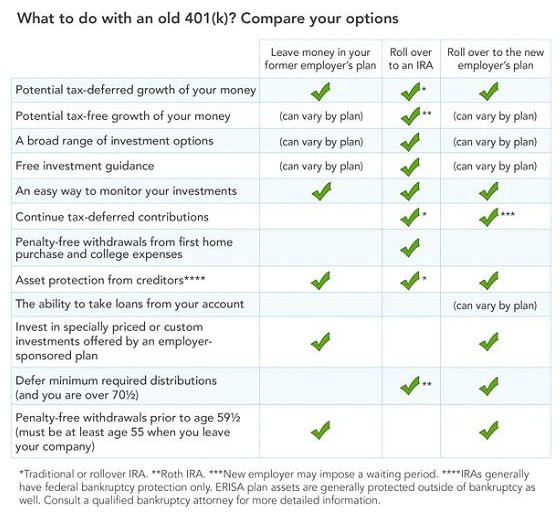401K Rollover Options
Post on: 16 Март, 2015 No Comment

401k Rollover Options
If you are in the process of changing jobs or retiring
you’ll want to consider your 401k rollover options.
If youve left a job where you had a 401k, you might consider rolling over your 401k into an account that
you can have more control over. You generally dont have the ability to move your 401k without incurring a
penalty, but once you change jobs you have the flexibility to move your 401k without paying penalties and
taxes as long as you move the 401k within a certain period of time.
A 401k rollover lets you move the money in your retirement account into another one, perhaps one that
you like better.
Your New Employers Qualified Plan
If your new employer has a 401k or 403b a 403b is a retirement savings for some non-profit employers
and schools you may be able to transfer your previous 401k savings into a plan offered by your current
employer. If you decide to rollover into a new 401k you wont be able to touch the money without penalty
unless you take out a loan or you change employers again.
Different employer plans have different contribution rules. Your new employers 401k plan may not allow
you to transfer money into your account or there may be a minimum investment amount that prevents you
from transferring your money if you dont have enough. Before you initiate the rollover process, check with
your new employers retirement plan administrator to learn whether there are any limitations on 401k
rollovers.
If youre now self-employed, you may rollover your 401k into an Individual 401k, a retirement option for
self-employed individuals. You can open an Individual 401k if you are self-employed with no employees,
even if your business is incorporated.
Rollover Into an IRA
You can move your retirement savings into an IRA. Individual Retirement Account. IRAs allow you to
continue to contribute tax-deferred money for retirement and they give you more choices for investing
than your employers 401k plan. You can rollover a 401k into a traditional IRA, Roth IRA, or SEP-IRA.
Note that if you rollover into a Roth IRA, you wont be able to rollover those same funds into a different
employer-sponsored retirement plan.
Keep in mind that if you make a IRA rollover. you wont be able to access the funds via loan as you could
with a 401k. Your only option, if you have no choice but to tap into retirement savings, is to take a
withdrawal and pay the penalty and taxes.
401k Time Limit
To avoid penalties, it may be best to transfer your 401k
savings directly into your new retirement plan. Otherwise,
if you plan to do an indirect 401k rollover where you get
a check for the balance of your 401k that you can

deposit into your new account you have 60 days to
make deposit the check into your new retirement plan.
Otherwise, you face the early withdrawal penalty.
Rolling Over With an 401k Loan
If you left your previous company with a 401k loan. you
may be required to pay the balance of the loan in full
before you can rollover the rest of your 401k savings.
Unfortunately, if you cant afford to repay the loan, the
amount you borrowed will be treated as a withdrawal and youll face early withdrawal penalty. This will
reduce the amount youre able to rollover into a new plan.
Is a 401k Rollover Required?
You dont have to rollover your 401k after you leave your employer. Instead, you can cash out your 401k.
Your employer will send you a check for the balance of your 401k minus a 20% mandatory penalty
imposed by the IRS if you receive the 401k distribution before you turn 59 . You also have to report the
distribution as taxable income and pay an additional penalty.
Alternatively, you can leave your 401k right where it is, especially if your ex-employers retirement plan
had lower fees than an IRA or your new employers retirement plan. You might also leave your 401k if you
prefer the smaller number of investment options offered by your old employers plan.














